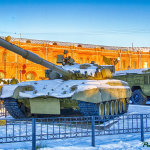In May 2024, The Wavell Room published an article on Ukraine’s expanding, deep strike campaign using long-range drones (‘Ukraine’s strikes against Russian oil refineries’). The article concluded: ‘A better assessment should be possible by the end of the year. Kyiv is deliberately expanding the range of targets beyond the oil refineries. Putin’s ‘special military operation’ has taken yet another twist he never imagined.’
This article reviews Ukrainian deep strikes almost one year on from the expansion of the strategic drone campaign. Over this period, Kyiv has targeted ammunition storage sites, defence factories, military airfields, radars, fuel depots and refineries. Deep strike attacks are weekly events. As at last October, Ukraine had mounted more than 7,000 cross-border drone strikes, the longest deep strike ranged at 1,700 kilometres. The numbers have grown again. These deep strikes are vindicated on the grounds they weaken Russia’s frontline forces. But do they? What is the evidence?

Intensity of Russian offensive actions
Only one side is attacking across all fronts – Russia. The Ukrainian MOD publishes a 24-hour summary of the fighting. Latest data summarising the actions up to the time of writing (1-20 March) is below. ‘Combat clashes’ are Russian attacks – typically small-scale infantry ‘meat assaults’. Air strikes and bombs launched refer to tactical bombing and glide (guided) KAB bombs. Kamikaze drone data vary in accuracy: some data are stated precisely; others are estimates. ‘Shellings’ refer to individual shells (or rockets), not salvos. The data is assumed to be the least accurate.
| Date (reporting is at 10pm) | ‘Combat clashes’ | Air strikes | Bombs/missiles launched | Kamikaze drones | ‘Shellings’ (includes rocket fire) |
| Sat 1 (24 hours) | No data | ||||
| Sun 2 (24 hours) | 109 | 88 | 126 | 2,375 | ‘more than 5,600 attacks, including 124 from multiple-launch rocket systems’ |
| Mon 3 (24 hours) | 101 | 56 | 104 | 2,638 | ‘5,100 attacks, 186 of them with MLRS’ |
| Tue 4 (24 hours) | 108 | 56 | 90 | 2,234 | ‘about 4,800 attacks, 185 of them from multiple launch rocket systems’ |
| Wed 5 (24 hours) | 109 | 85 | 121 | 2,547 | ‘more than 4,000 attacks, 144 of them from multiple launch rocket systems’ |
| Thu 6 (24 hours) | 146 | 89 | 149 | 2,729 | ‘over 5,100 attacks, 194 of which were from multiple launch rocket systems’ |
| Fri 7 (24 hours) | No data | ||||
| Sat 8 (24 hours) | 167 | 83 | 103 | 3,229 | ‘6,200 attacks, 217 of them from multiple launch rocket systems’ |
| Sun 9 (24 hours) | 151 | 91 | 148 | 2,576 | ‘almost 6,700 attacks, 186 of which were from multiple-launch rocket systems’ |
| Mon 10 (24 hours) | No data | ||||
| Tue 11 (24 hours) | 259 | 74 | 116 | 2,285 | ‘about 5,000 attacks, 156 of which were from multiple-launch rocket systems’ |
| Wed 12 (24 hours) | 138 | 98 | 150 | 2,283 | ‘5,200 attacks, including 147 from multiple launch rocket systems’ |
| Thu 13 (24 hours) | 146 | 103 | 154 | 2,509 | ‘about 6,000 attacks, 166 of them from multiple rocket launcher systems’ |
| Feb 14 (14 hours) | 146 | 103 | 154 | 2,509 | ‘about 6,000 attacks, 166 of them from multiple rocket launcher systems’ |
| Sat 16 (24 hours) | No data | ||||
| Sun 16 (24 hours) | 112 | 81 | 135 | 2,534 | 5,794 |
| Mon 17 (24 hours) | 155 | 90 | 139 | 2,506 | ‘5,771 artillery shelling, including 145 from multiple launch rocket systems’ |
| Tue 18 (24 hours) | 155 | 90 | 139 | 2,506 | ‘5,771 artillery shelling, including 145 from multiple launch rocket systems’ |
| Wed 19 (24 hours) | No data | ||||
| Thu 20 (24 hours) | 166 | 94 | 151 | ‘about 3,000’ | ‘6,449 attacks, including 187 from multiple launch rocket systems’ |
What can we conclude from the data? First, there is no discernible correlation between Ukrainian deep strikes and the intensity of Russian attacks. The rhythm is basically determined by the availability of ‘meat’ – Russian soldiers converted into corpses in the daily tide of ‘meat attacks’. Where the command makes a special effort to capture settlements there are peaks. When exhaustion sets in there are troughs. This is illustrated in the graph below that shows the deep strikes over the first 13 days of November. The two peaks relate to maximum efforts made to outflank Kurakhove. Most recently there has been another surge in attacks to try to seek advantage in the truce negotiations i.e. capture more territory before any temporary ceasefire.

Second, artillery is not the reason why Russian forces eventually overcome Ukrainian defences. The daily average of around 5,500 shells expended across the several fronts is not great. This expenditure has actually been rising (it was around 3,000 shells towards the end of 2024), no matter how many artillery systems are destroyed or ammo storage sites hit. Russian gunnery remains poor: uncoordinated, unresponsive and inaccurate.
Third, the tactical bombing campaign is weak. It cannot even be compared with NATO’s Op ALLIED FORCE (Kosovo 1999), criticised at the time as insufficient (around 450 daily strike sorties were mounted by the end of the70-odd day operation). The low Russian daily sortie rate (around 60) is compounded by the inaccuracy of the guided KAB bombs. Ukrainian EW has increased that inaccuracy by interfering with the GLONASS guidance.
Lastly, the rise of the tactical, front line drone has been phenomenal. There were no attacks in 2022. Today, a peak day may witness over 3,000 kamikaze drone attacks. This is why everybody stays underground or under cover.
Russian territorial gains
Another measure is Russian territorial gains. These have recently slowed with the exception of Kursk where Ukrainian forces have almost been expelled from the salient they had held since August last year. Nevertheless, over November 2024, Russian forces captured about 600-667 sq km of territory, or an area half the size of London. From September, more ground had been captured than in all of 2023. Over the autumn-winter, 88 settlements were lost.

The two key events leading to collapses of the frontline were the fall of Avdiivka in February and loss of Vuhledar in October, following a stout two year defence by 72nd Mechanised Brigade (72 OMBr). The defenders know perfectly well why these setbacks are happening. ‘Ukraine mobilizes three to five thousand people per month,’ a dispirited Lieutenant-Colonel Pavel Kurylenko, CO of 72 OMBr remarked, ‘while the enemy mobilizes 30-40 thousand per month.’ In the end, manpower decided the matter.
The unchanging verities of war: ‘The pure math of Ukraine’s situation now is that it needs more troops in the fight.’
So opined an unnamed source in the outgoing Biden administration. Before the invasion of Ukraine, many warfares paraded their wares in the great bazaar of conflict: multi-domain operations, effects-based operations, deep-recce strike, asymmetric warfare, a manoeuvrist approach to warfare, grey zone warfare, hybrid warfare, cyber warfare, limited warfare, below-threshold conflict, next-gen warfare, fourth (or fifth) generation warfare, warfare 2.0, and many more faddish, buzz terms. All have been trumped.
Real warfare has proved to be not so different after all. Of course there has been a revolution in tactical drones. But the fundamentals are unchanged. Wars are total, all-consuming, and industrial. The basic unit of measurement of war is a soldier. The coefficient is high explosives. Hundreds of thousands of young men must be mobilised, armed, and sent to a front line. Kyiv is finding this truism hard to reckon. Losing Ukraine will be harder still.
Sergio Miller
Sergio Miller is a retired British Army Intelligence Corps officer. He was a regular contributor and book reviewer forBritish Army Review. He is the author of a two-part history of the Vietnam War (Osprey/Bloomsbury) and is currently drafting a history of the Russian invasion of Ukraine.




